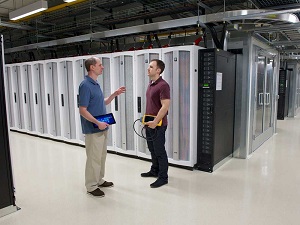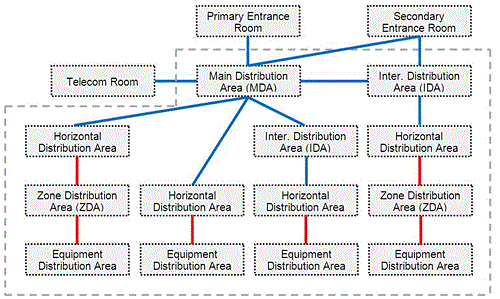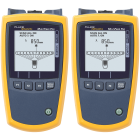Testing in the Data Center Spaces
July 25, 2018 / General, Installation and testing, Upgrading and troubleshooting, Industrial Networks
Depending in which functional area of the data center you are testing, there are different applications, cabling and connectivity that you will encounter. Understanding the functional areas of the data center and what you will likely need to test in each can help prepare you for data center testing.
What Are the Spaces?
Industry standards like the ANSI/TIA-942-A Infrastructure Standard for Data Centers, ISO/IEC 24764 Information technology - Generic Cabling Systems for Data Centres and ANSI/BICSI 002-2014 Data Center Design and Implementation Best Practices outline the specific functional areas of the data center that define equipment placement.
As shown in the TIA-942-A standard, the functional areas of the data center are connected by backbone cabling (blue) and horizontal cabling (red), and the standards outline the minimum recommendations for the cable media and distances between each space. But what exactly is the purpose of each space?

- The Entrance Room (ER) can be located inside or outside of the data center, and it is where the service enters the data center. It contains demarcation points to the service provider’s network and backbone cabling to other buildings in a campus environment.

- The Main Distribution Area (MDA) houses core switches and routers for connecting to the LAN, SANs and other areas of the data center, as well as telecommunications rooms (TRs) located throughout a facility.
- The Intermediate Distribution Area (IDA) is an optional area primarily used in large data centers. Referred to as an intermediate distributor (ID) in the ISO/IEC 24764 standard, IDAs may include intermediate cross-connects and are designed to enable data center growth or provide segmentation for specific applications.
- The Horizontal Distribution Area (HDA) serves as the distribution point for the Equipment Distribution Area (EDA). While most data centers will contain at least one HDA, it is typically eliminated in data centers using a top-of-rack (ToR) configuration where access switches residing in each cabinet in the EDA connect directly to switches in the IDA or MDA.
- The Zone Distribution Area (ZDA) is also optional and not commonly used in most enterprise data centers. It essentially servers as a consolidation point within the horizontal cabling between the HDA and the EDA and contains no active equipment.
- The Equipment Distribution Area (EDA) houses the end equipment (e.g., servers) that connect via horizontal cables from access switches in the HDAs or via point-to-point cabling to ToR access switches that reside in the same cabinet.
What Will You be Testing?
With each functional space of the data center having its own purpose and equipment that connects either via backbone or horizontal cabling, you should be prepared to test a variety of cabling media for various applications.
For example, in the MDA, you will likely find singlemode or multimode fiber links from the ER running 40 and 100 Gig applications, which will require Tier 1 certification. However, in the ER you may also need to perform Tier 2 testing with an Optical Time Domain Reflectometer (OTDR) such as Fluke Networks’ OptiFiber® Pro due to longer outside plant cable runs between buildings, difficulty in physically inspecting the fiber and the common use of fusion splicing to transition from outside plant fiber to premise fiber. Be prepared to also test multi-fiber MPOconnectivity, which is required to support higher bandwidth multimode applications such as 40 and 100GBASE-SR4. This is where using a tester with MPO testing capabilities such as Fluke Networks’ MultiFiber™ Pro Optical Power Meter will save time and improve accuracy.
Once you move into the horizontal cabling between the HDA and EDA (i.e., switch-to-server links), you will most likely encounter Category 6 or higher copper connections for applications like 1000BASE-T or 10GBASE-T. These are also the areas of the data center where Category 8 cabling will be found to support upcoming 25GBASE-T and 40GBASE-T switch-to-server applications, so ideally, you want a copper certification tester for this space that can test everything from Category 5e to Category 8 such as Fluke Networks’ DSX CableAnalyzer™ Series tester.
If the EDA uses a ToR configuration with point-to-point cabling between ToR switches and servers in the same cabinet, you may also find SFP+ or SFP28 twinax direct attach cables (DACs) used for these connections. You may also encounter QSFP+ and QSFP28 DACs for point-to-point connections from SAN switches to storage equipment. Testing SFP/QSFPs modules involves verifying that power is properly being delivered.
Want to Learn More?
Since the data center can contain several types of cabling and a wide range of applications, there are also a wide range of performance parameters and best testing practices to consider for each. To delve deeper into the functional areas of the data center, what is typically being tested in each and the key considerations for the various cabling systems and applications you may encounter, click HERE to download the free white paper, In the Data Center—Where and What Am I Testing?








